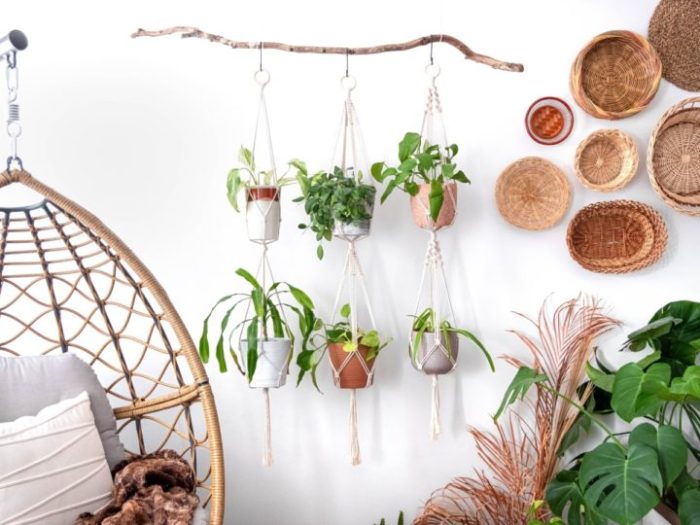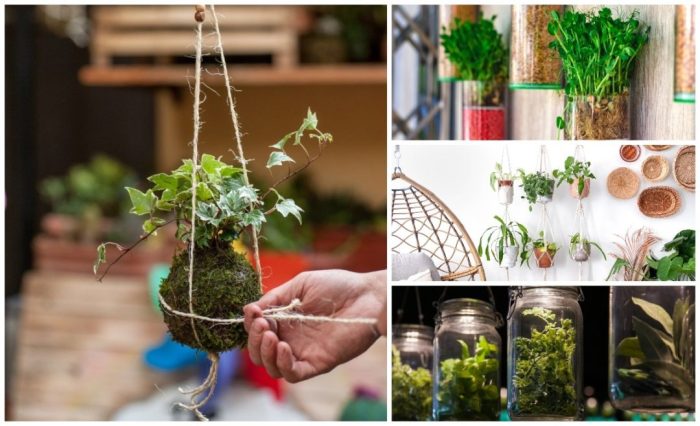Hanging plants for small spaces are a stylish and practical solution to bring life and greenery into your limited square footage. Not only do they add a touch of nature, but they also optimize vertical space and purify the air.
From lush ferns to cascading succulents, there’s a wide variety of hanging plants to choose from, each with its unique charm and care requirements. Discover the best types, planters, and design ideas to transform your small space into a verdant oasis.
Hanging Plant Benefits for Small Spaces: Hanging Plants For Small Spaces

Hanging plants offer a plethora of advantages for small spaces, maximizing vertical space and creating an inviting ambiance. They optimize the use of limited floor area, allowing for more functional and visually appealing living spaces.
By utilizing vertical space, hanging plants free up precious floor space, making rooms feel more spacious and less cluttered. They add a touch of greenery and life to small apartments, balconies, or any room with limited square footage.
Air Purification and Ambiance
Hanging plants not only enhance the aesthetics of a space but also contribute to a healthier environment. Many plants possess air-purifying properties, removing harmful toxins and improving indoor air quality. They release oxygen, creating a fresher and more invigorating atmosphere.
Moreover, hanging plants can add a sense of tranquility and relaxation to a space. Their lush foliage and cascading greenery create a calming effect, reducing stress and promoting well-being.
Types of Hanging Plants for Small Spaces
Hanging plants are a great way to add life and color to a small space. They can be used to create a vertical garden, add privacy, or simply add a touch of nature to your home. Here are a few of the best hanging plants for small spaces:
When choosing a hanging plant for a small space, it is important to consider the size of the plant, its light requirements, and its watering needs. You will also want to choose a plant that is easy to care for and that will not require a lot of maintenance.
Table of Hanging Plants for Small Spaces
The following table provides a list of hanging plants that are suitable for small spaces, along with their size, light requirements, and watering needs:
| Plant Name | Size | Light Requirements | Watering Needs |
|---|---|---|---|
| Boston Fern | Small to medium | Bright, indirect light | Water when the top inch of soil is dry |
| String of Pearls | Small | Bright, indirect light | Water when the soil is completely dry |
| Burro’s Tail | Small to medium | Bright, indirect light | Water when the soil is completely dry |
| Spider Plant | Small to medium | Bright, indirect light | Water when the top inch of soil is dry |
| Pothos | Small to large | Low to bright, indirect light | Water when the top inch of soil is dry |
These are just a few of the many hanging plants that are suitable for small spaces. When choosing a plant, be sure to consider the size of the plant, its light requirements, and its watering needs. You will also want to choose a plant that is easy to care for and that will not require a lot of maintenance.
Choosing the Right Hanging Planter

Selecting the right hanging planter is crucial to complement your plant and create a harmonious visual appeal. Consider the following factors when making your choice:
Material
Hanging planters come in various materials, each offering unique aesthetics and functionality:
- Macrame:Woven from cotton or jute, macrame planters add a bohemian touch to your space.
- Ceramic:Durable and stylish, ceramic planters are available in a wide range of colors and shapes.
- Metal:Lightweight and modern, metal planters provide a sleek and contemporary look.
Size and Weight
Choose a planter that is proportionate to the size of your plant. A too-small planter will restrict root growth, while a too-large one can overwhelm the plant. Consider the weight of the plant when filled with soil to ensure the planter can support it securely.
Style, Hanging plants for small spaces
The style of the planter should complement the decor of your space and the overall aesthetic you wish to create. For a cohesive look, consider using multiple hanging planters in similar styles or materials, varying only in size.
Hanging Plant Care
Hanging plants require specific care to thrive in their unique environment. Understanding their watering, fertilization, and pruning needs is crucial for their health and well-being.
Watering techniques should consider the plant’s specific needs, allowing the soil to dry out slightly between waterings. Overwatering can lead to root rot, while underwatering can cause wilting and stunted growth.
Fertilization
Fertilizing hanging plants is essential for providing essential nutrients. Use a balanced liquid fertilizer diluted to half strength and apply it every two to four weeks during the growing season.
Pruning
Pruning helps maintain the shape and size of hanging plants. Remove dead or damaged leaves and stems, and trim back overgrown areas to encourage new growth. Pruning also helps prevent pests and diseases by improving air circulation.
Troubleshooting
Common problems with hanging plants include yellowing leaves, pests, and fungal diseases. Yellowing leaves can indicate overwatering, underwatering, or nutrient deficiency. Pests such as aphids or spider mites can be treated with insecticidal soap or neem oil. Fungal diseases like powdery mildew can be managed by increasing air circulation and using fungicides.
Hanging Plant Design Ideas

Hanging plants are a great way to add life and personality to small spaces. They can be used to create focal points, divide spaces, or add texture to walls. Here are a few ideas for hanging plant designs:
To create a focal point, hang a large, trailing plant in the center of a room. This will draw the eye and create a sense of drama. You can also use a group of smaller plants to create a more subtle focal point.
To divide a space, hang plants from the ceiling to create a visual barrier. This can be a great way to separate a living room from a dining room or a bedroom from a home office.
To add texture to walls, hang plants on walls that are bare or painted in a neutral color. The plants will add visual interest and make the space feel more inviting.
Hanging Plants in Different Room Types
Hanging plants can be used in any room in the house, but they are especially well-suited for small spaces. Here are a few ideas for hanging plants in different room types:
- Living room:Hang a large, trailing plant in the center of the room to create a focal point. You can also use a group of smaller plants to create a more subtle focal point.
- Kitchen:Hang plants from the ceiling to create a visual barrier between the kitchen and the dining room. You can also hang plants on the walls to add texture and color.
- Bedroom:Hang a small plant from the ceiling above your bed to create a calming atmosphere. You can also hang plants on the walls to add a touch of nature to your bedroom.
Wrap-Up
Whether you’re looking to create a focal point, divide spaces, or simply add a touch of greenery, hanging plants are a versatile and impactful addition to any small space. Embrace the vertical dimension and bring the beauty of nature into your home with these practical and stylish solutions.
FAQ Overview
How do I choose the right hanging planter?
Consider the size, weight, and style of your plant. Macrame planters are lightweight and bohemian, while ceramic planters are durable and elegant. Metal planters offer a modern and industrial touch.
What are the most low-maintenance hanging plants?
Spider plants, pothos, and snake plants are known for their resilience and require minimal care. They tolerate a wide range of light conditions and infrequent watering.
Can I hang plants in my bathroom?
Yes, but choose plants that thrive in humid environments, such as ferns, air plants, and orchids. Ensure adequate ventilation to prevent mold growth.